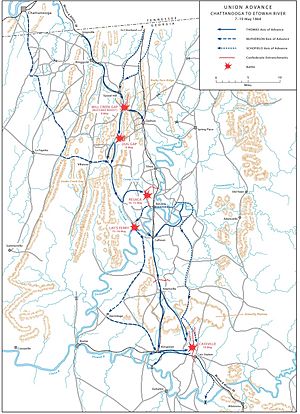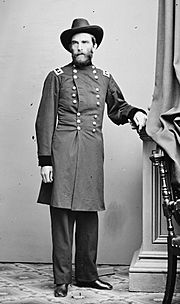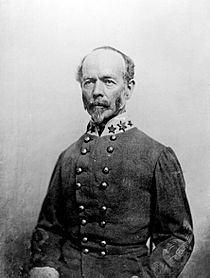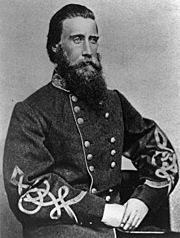Battle of Resaca facts for kids
Quick facts for kids Battle of Resaca |
|||||||
|---|---|---|---|---|---|---|---|
| Part of the American Civil War | |||||||
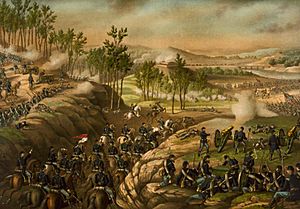 Battle of Resaca, by Kurz and Allison, 1889. |
|||||||
|
|||||||
| Belligerents | |||||||
| Commanders and leaders | |||||||
|
|||||||
| Units involved | |||||||
| Military Division of the Mississippi | Army of Tennessee | ||||||
| Strength | |||||||
| 98,787–110,000 | 60,000–70,000 | ||||||
| Casualties and losses | |||||||
| 2,747–4,000 | 2,800–3,000, 4 guns | ||||||
The Battle of Resaca was a major fight during the American Civil War. It happened from May 13 to 15, 1864, in Georgia. This battle was part of the larger Atlanta Campaign. The Union army, led by General William Tecumseh Sherman, fought against the Confederate army, led by General Joseph E. Johnston. The battle took place in Gordon and Whitfield Counties, Georgia. It is usually seen as an inconclusive battle, meaning neither side won a clear victory.
The campaign started with Johnston's troops in strong defensive spots. These were at Buzzard's Roost Gap and Rocky Face Ridge. Sherman wanted to avoid a direct attack on these strong points. Instead, the Union Army of the Tennessee, led by General James B. McPherson, found an unguarded path. This path was Snake Creek Gap. On May 8, McPherson's troops took control of it. This move threatened the town of Resaca from the west.
Because of this threat, Johnston had to leave his positions at Dalton. He moved his army back to Resaca. There, he was joined by more Confederate soldiers. Sherman's forces followed him. Most of Sherman's army went through Snake Creek Gap. Other Union troops came south along the Western and Atlantic Railroad.
On May 14, Sherman's army gained a small foothold west of Resaca. However, their attacks on Confederate defenses were pushed back. A Confederate attack on the Union army's left side also failed later that day. On May 15, another Union attack was stopped. A Confederate counterattack also failed. But other Union forces managed to cross the Oostanaula River. This threatened Johnston's escape route. Because of this, Johnston left Resaca that night. He moved his army south to Adairsville. A small fight, called a skirmish, happened there on May 17.
Contents
Why the Battle Happened
The Union Army's Plan
General Sherman was in charge of the Union forces. He had about 110,000 soldiers ready for battle. About 99,000 of these were prepared for attacking. The Union army also had 254 cannons. Many non-soldiers, like railroad workers and medical staff, also traveled with the army.
Sherman's army was made up of three main groups. General George H. Thomas led the Army of the Cumberland. General James B. McPherson led the Army of the Tennessee. General John Schofield led the Army of the Ohio. These groups combined to form a very large fighting force.
The Confederate Army's Plan
General Johnston commanded the Confederate Army of Tennessee. His army had two main groups of infantry. These were led by Generals William J. Hardee and John Bell Hood. General Joseph Wheeler led the cavalry. Later, General Leonidas Polk and his troops joined Johnston.
On April 30, Johnston's army had about 41,000 infantry soldiers. They also had about 8,400 cavalry and 3,200 artillerymen with 144 cannons. More troops joined Johnston's army in May. After these reinforcements, Johnston had about 60,000 to 70,000 soldiers.
Sherman's Strategy for Atlanta
General Ulysses S. Grant, the top Union general, told Sherman to attack Johnston's army. Sherman's main goal was to push Johnston's army back to Atlanta. Atlanta was a very important city for the Confederacy. It was a major center for railroads, supplies, and making war materials.
Sherman needed to gather a lot of supplies. He wanted enough food and equipment for 100,000 soldiers and 35,000 horses for 70 days. This way, if the Confederates cut the railroad, his army could still fight. Sherman managed to get all the supplies he needed by the end of April 1864. The Western and Atlantic Railroad was key. It connected Chattanooga with Atlanta and also supplied Johnston's army.
Sherman's first plan was to send McPherson's army through Snake Creek Gap. They would then destroy the railroad at Resaca. After that, McPherson would pull back. Meanwhile, Sherman wanted his other armies to attack Johnston from the front. With the railroad cut, Sherman thought Johnston would have to retreat. Then McPherson would attack Johnston from the west, while the others attacked from the north.
The Confederate government wanted Johnston to attack the Union army. But Johnston asked for more soldiers. Confederate President Jefferson Davis said no. He thought the main Union attack would be in the east. He didn't believe Sherman had such a large army in the west.
Early Movements of the Armies
As Sherman's army moved, Johnston started getting more troops. On May 3, Sherman's forces began to move. Different parts of his army marched towards various points. Some went towards Tunnel Hill, others towards Rocky Face Ridge.
On May 8, Union troops tried to break through Rocky Face Ridge. These attacks were meant to distract Johnston. They wanted him to focus on the ridge, not on McPherson's troops. Confederate cavalry did spot McPherson's column. But Johnston thought they were going to a different town, Rome. He sent some of his own troops there.
On May 9, McPherson's troops marched through Snake Creek Gap. This gap was about 4 miles long. They reached the southern end of the gap. Johnston was told that Union troops were near Villanow. So, he ordered his cavalry to guard Snake Creek Gap.
On May 10, McPherson's leading troops met Confederate cavalry. The Confederates tried to slow them down. By 2 PM, Union troops were about 2 miles west of Resaca. They pushed back a Confederate force defending Bald Hill. The Confederate commander, Cantey, had only about 4,000 men to defend Resaca.
McPherson's troops got very close to the railroad. But McPherson worried it was a trap. He pulled his troops back to Snake Creek Gap. They only managed to cut some telegraph wires.
The Battle Begins
Setting the Stage
On May 9, Union forces tested the Confederate defenses at Rocky Face Ridge. Johnston had his troops spread out. When he heard about Union forces at Snake Creek Gap, he sent more troops to Tilton, near Resaca. On May 10, Sherman learned McPherson hadn't cut the railroad. He quickly sent more troops to Snake Creek Gap.
On May 11, General Polk arrived at Resaca with more Confederate soldiers. The next day, more Union troops arrived. Johnston then left Dalton and marched his army south to Resaca.
On May 12, Sherman met McPherson. Sherman told him he had "missed the opportunity of a lifetime" by not cutting the railroad. Soon after, Sherman learned Johnston's supply wagons were moving south. This meant the Confederates were likely retreating. Sherman ordered his troops to hurry to Resaca.
By the morning of May 13, Sherman's forces were close to Resaca. Union cavalry led a scouting mission, and their commander, Kilpatrick, was wounded. Union troops pushed back Confederate skirmishers. By evening, Sherman's forces were lined up outside Resaca. They faced Johnston's main army, which was well-defended.
Johnston placed General Polk's troops on the left side, resting on the Oostanaula River. Hardee's troops were in the center. Hood's troops were on the right, touching the Conasauga River.
Fighting on May 14
Sherman thought Johnston planned to retreat from Resaca. He saw Confederate wagons crossing the Oostanaula River. Johnston, however, hoped Sherman would attack him. He wanted a chance to strike back hard. Sherman ordered his engineers to build pontoon bridges. These would let his cavalry cross the Oostanaula River and damage the railroad. He also wanted his infantry to attack to keep Johnston busy.
When more Union troops arrived from the north, Sherman ordered an attack. He thought they were hitting the Confederate right side. But they were actually attacking the right-center. Union soldiers struggled through thick bushes. They suddenly faced strong Confederate defenses. One Union division charged and was pushed back with heavy losses. Another division captured some advanced rifle pits after a tough fight. Union artillery then fired heavily on the Confederate lines.
Later in the afternoon, Johnston saw a weak spot in the Union lines. He ordered General Hood to attack it. Confederate divisions advanced. They overwhelmed some Union brigades. But when they tried to capture Union cannons, they were driven back by fierce fire. The Confederates tried again but were stopped by more Union infantry and cannon fire. By the time they tried a third attack, Union reinforcements arrived and pushed them back.
Meanwhile, Union troops found a weakness in the Confederate skirmish line. They captured a bridge over Camp Creek. McPherson, seeing Confederates moving troops north, ordered two brigades to capture a hill. They crossed the creek and took the hill. Confederates tried three times to retake the hill but failed. Artillery on the hill could hit the railroad bridges. So, Johnston ordered a new pontoon bridge built out of cannon range. At Lay's Ferry, Union troops successfully crossed the Oostanaula River. But they pulled back after a false report about a Confederate bridge upstream.
Fighting on May 15
On May 15, Sherman ordered his troops to attack from the north. McPherson's troops were told to hold their ground. Schofield's troops were moved to the left side. Johnston had planned to attack the Union left again. But he canceled it when he heard Union forces had crossed the Oostanaula River.
In the morning, only a small cavalry fight happened. At 1 PM, a Union attack was immediately pushed back by heavy fire. One general reported losing 120 soldiers in just thirty seconds.

To the left of this attack, Union troops charged with about 12,000 men. The terrain was rough, with thick bushes and ravines. This mixed up the attacking units. Union soldiers came out in a disorganized way, and their attacks were pushed back. However, one brigade, led by future President Benjamin Harrison, charged and captured some Confederate cannons. Confederate counterattacks pushed them back. But another Union brigade retook the cannons before also being driven back. The cannons were left in the middle, with neither side able to claim them. This Union attack gained no ground and suffered many casualties.
After Johnston learned the Union troops at Lay's Ferry were no longer a threat, he ordered Hood to attack the Union left again. At 4 PM, the attack began. But soon after, Johnston heard that Union troops were across the Oostanaula at Lay's Ferry again. Johnston tried to cancel the attack, but it was too late. The Confederate brigades came out of the forest one at a time. They were badly beaten by Union troops.
That evening, Johnston decided to retreat from Resaca. He knew Sherman's army was strongly dug in. He also saw that the Union troops at Lay's Ferry were a direct threat to his escape route. Johnston ordered his army to use the railroad and wagon bridges, plus a pontoon bridge. Only four cannons were left behind. The Confederate army crossed the Oostanaula bridges by 3:30 AM. Union soldiers found the Confederate trenches empty at 3 AM. Johnston's engineers removed the pontoon bridge and tried to burn the other two. But Union soldiers saved the wagon bridge and captured some stragglers.
What Happened Next
The Battle of Resaca resulted in many casualties. Union losses were about 2,700 to 4,000 soldiers. Confederate losses were around 2,800 to 3,000 soldiers, and they lost 4 cannons. The battle is considered inconclusive. This means neither side won a clear victory.
Sherman forced Johnston to leave two strong defensive positions. But the Confederate army managed to escape both times. Some historians criticize Sherman for his costly attacks and for not fully using his advantages. Johnston's retreat was well-planned and carried out. Even so, Sherman pushed Johnston closer to Atlanta. He also made sure Johnston could not send troops to help General Robert E. Lee in the east.
Sherman hoped to catch Johnston's retreating army between the Oostanaula and Etowah Rivers. This area was more open country. Sherman sent cavalry and infantry to follow the Confederates. Union troops crossed the rivers and marched south. Johnston retreated towards Adairsville, hoping to fight another defensive battle there.
Resaca Battlefield State Historic Site
Today, the battlefield is a preserved historic site. It is called the Resaca Battlefield State Historic Site. You can visit it on Fridays and weekends. The address is 183 Resaca Lafayette Rd., Resaca, GA 30735. Groups like the American Battlefield Trust have helped save over 1,000 acres of the battlefield. Local groups also created a 500-acre park along Camp Creek.
In Popular Culture
The short story Killed at Resaca by Ambrose Bierce is about a brave officer who dies during the battle.
Images for kids
-
Western and Atlantic Railroad at Allatoona Pass during the Civil War




